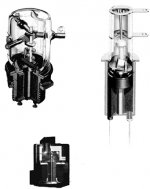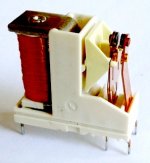In that case you would also need to apply some sealant around the 2 small 'latches' on the sides at the base of the enclosure where the upper part of the body is fixed to the base.
Left 'as standard' these will still permit an exchange of air through the slots in the sides of the upper cover.
However, my understanding is that 'production' hermetically-sealed relays would often be filled with an inert gas, like Argon or similar, I believe.
Left 'as standard' these will still permit an exchange of air through the slots in the sides of the upper cover.
However, my understanding is that 'production' hermetically-sealed relays would often be filled with an inert gas, like Argon or similar, I believe.
Jan, you have stated a 'conclusion' about cables that doesn't hold up with experience. You say that what we hear in cable differences is just how clean the connectors are. This flies in the face of any REAL cable comparison, where cables are exchanged back and forth in a short time. or even over an extended listening period. We are not 'children', who just to conclusions.
As far as relays are concerned, it is difficult to get really dirty contacts from limited air exposure, because the relay being used at the output of the amp, will 'blow through' limited films. Of course, in a corrosive industrial environment, this may not be so, but relay manufacturers know that relays of 5A or so rating, are not designed to be used in 'dry' contact environments.
john curl said:Jan, you have stated a 'conclusion' about cables that doesn't hold up with experience. You say that what we hear in cable differences is just how clean the connectors are. This flies in the face of any REAL cable comparison, where cables are exchanged back and forth in a short time. or even over an extended listening period. We are not 'children', who just to conclusions.
John, I didn't mean to say that this is ALWAYS the case, of course not. It's just part of MY experience, over many years, again and again.
Edit: spelling
Jan Didden
BTW It's not only the corrosion but also the 'seating'. Depending on the mechanical quality of connectors and jacks, and the 'robustness', stiffness and flexibility of (arm-thick) cables, many connections lose their firm grip over time. That also can be a source of degrading sound. I know, I've heard it 😉
Jan Didden
Jan Didden
Bobken said:[snip]However, my understanding is that 'production' hermetically-sealed relays would often be filled with an inert gas, like Argon or similar, I believe.
Really? Didn't know that, but makes sense. Are these expensive?
Jan Didden
janneman said:
Really? Didn't know that, but makes sense. Are these expensive?
Jan Didden
Or you could use "mercury wetted" relays, but look out for the cost...
They do have a fantastic reliability and current breaking capacity.
Almost all signal switching relays war made with gas filling, either nitrogen or argon. You know the plastic dpdt 2A type with gold over silver contacts.
Many useful POWER relays are made for automotive applications, these days. Low cost, high quality, advanced contacts.
Many useful POWER relays are made for automotive applications, these days. Low cost, high quality, advanced contacts.
The question remains. Is it better to have no arcing at all or a little bit and for what kind of contact coating.
JPV
JPV
Some info..
http://relays.tycoelectronics.com/kilovac/hvintro/vacuum.asp
$300 usd tycoelectronics, mostly HV use. (Attached)
http://relays.tycoelectronics.com/kilovac/hvintro/vacuum.asp
$300 usd tycoelectronics, mostly HV use. (Attached)
Attachments
Hi Jan,
Another thought. All contacts suffer bounce (except mercury whetted contacts). A small capacitor may help with the arcing that is sure to occur then. It really was just a thought that might improve the subjective impact of a speaker relay.
Hi John,
Power supply breakers are probably a good idea. Before or after the rectifiers? I'm thinking before to minimize the energy during break. DC is brutal.
-Chris
As long as the contacts continue to wipe clean, no problem. I am thinking that the capacitor may help past some small details after the contacts had degraded slightly. Planning for the future so to speak.What would the effect be of 0.1uF across 0.01 ohms contact resistance?
Another thought. All contacts suffer bounce (except mercury whetted contacts). A small capacitor may help with the arcing that is sure to occur then. It really was just a thought that might improve the subjective impact of a speaker relay.
Hi John,
Power supply breakers are probably a good idea. Before or after the rectifiers? I'm thinking before to minimize the energy during break. DC is brutal.
-Chris
vacuum relays are typically used for HV and RF applications.
For RF it is fairly commonly used in antenna switches and for switching in high power exciters to biggggg amplifiers...
Don't think they're terribly applicable for this application, but who knows?
The Ruskies are exporting them now you can find 'em on epay if ur interested.
_-_-bear
For RF it is fairly commonly used in antenna switches and for switching in high power exciters to biggggg amplifiers...
Don't think they're terribly applicable for this application, but who knows?
The Ruskies are exporting them now you can find 'em on epay if ur interested.
_-_-bear
relay source
Hello Jan,
I know you used it on the PaX 😎. I guess it is an exclusive model made by/for them because it doesn't appear on my -scope anywhere and
-scope anywhere and
right now Amplimo doesn't list these (...probably because their website is still under re-construction).
I hope they still intend to sell these...Any "insider" news?
Sorry for OT,
Thanks
janneman said:On the risk that people think I have stock in Amplomo 😉 :
I have repeatedly mentioned their special speaker relay. ....
Jan Didden
Hello Jan,
I know you used it on the PaX 😎. I guess it is an exclusive model made by/for them because it doesn't appear on my
 -scope anywhere and
-scope anywhere andright now Amplimo doesn't list these (...probably because their website is still under re-construction).
I hope they still intend to sell these...Any "insider" news?
Sorry for OT,
Thanks
Re: relay source
Yeah their website is not a model of clarity. They still sell the relay though, just send them an email. I think they cost about $ 8 or so. They are not exclusive, I have been told there are more relays that have dual contacts, but somehow these are not 'visible' to the audio community.
Jan Didden
sidiy said:
Hello Jan,
I know you used it on the PaX 😎. I guess it is an exclusive model made by/for them because it doesn't appear on my-scope anywhere and
right now Amplimo doesn't list these (...probably because their website is still under re-construction).
I hope they still intend to sell these...Any "insider" news?
Sorry for OT,
Thanks
Yeah their website is not a model of clarity. They still sell the relay though, just send them an email. I think they cost about $ 8 or so. They are not exclusive, I have been told there are more relays that have dual contacts, but somehow these are not 'visible' to the audio community.
Jan Didden
Really? Didn't know that, but makes sense. Are these expensive?
Omron G6B relay, hermetically sealed, available as high-current version with 8A current rating, about 5 Euros at Digikey.
They don't mention in the datasheet what they use as filling though.
Have fun, Hannes
Edmond Stuart said:For the curious of mind the internals of the Amplimo relay:
what is your experience with this relay; is it making a practical difference
Thanks
JPV
While I think that this relay is interesting, I don't know how I could even buy it. Personally, I will stick with the more modern automotive relays for their price and availability. I can still get an A rating, using them. However, I do agree that power relays, in principle, are a problem, and should not be used for low power amps as output gates, or even most bridged designs.
- Status
- Not open for further replies.
- Home
- Amplifiers
- Solid State
- John Curl's Blowtorch preamplifier

